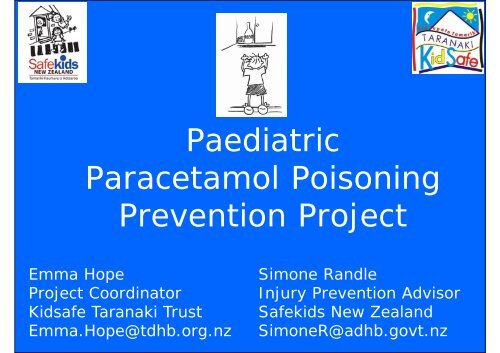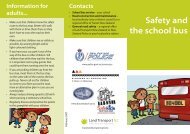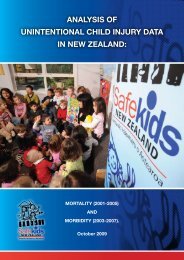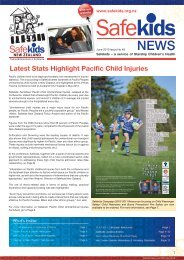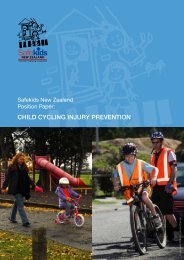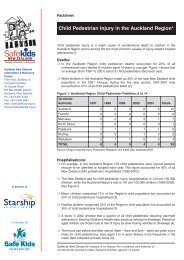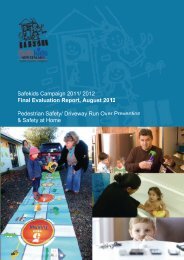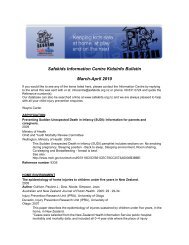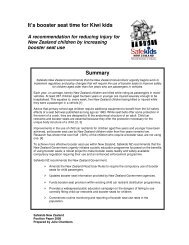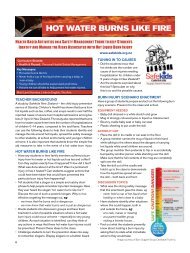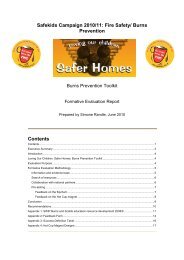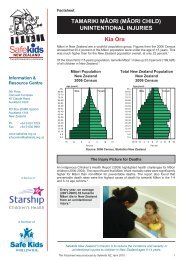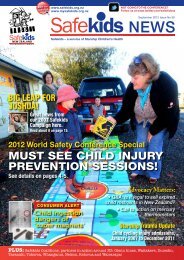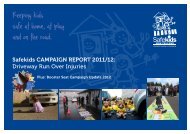Paediatric Paracetamol Poisoning Prevention Project - Safekids
Paediatric Paracetamol Poisoning Prevention Project - Safekids
Paediatric Paracetamol Poisoning Prevention Project - Safekids
You also want an ePaper? Increase the reach of your titles
YUMPU automatically turns print PDFs into web optimized ePapers that Google loves.
<strong>Paediatric</strong><br />
<strong>Paracetamol</strong> <strong>Poisoning</strong><br />
<strong>Prevention</strong> <strong>Project</strong><br />
Emma Hope<br />
<strong>Project</strong> Coordinator<br />
Kidsafe Taranaki Trust<br />
Emma.Hope@tdhb.org.nz<br />
Simone Randle<br />
Injury <strong>Prevention</strong> Advisor<br />
<strong>Safekids</strong> New Zealand<br />
SimoneR@adhb.govt.nz
Acetaminophen<br />
(<strong>Paracetamol</strong>)<br />
Brand Names include:<br />
– Panadol<br />
– Pamol<br />
– Tylenol<br />
• Commonly used for relief of pain and fever.<br />
• Overuse or misuse can lead to severe injury<br />
• Currently no limit on quantity of liquid paracetamol<br />
dispensed at any one time.
Taranaki Statistics<br />
27%<br />
Causes of injury related hospitalisations<br />
in Taranaki<br />
Falls<br />
41%<br />
<strong>Poisoning</strong><br />
Caught/ Crushed/<br />
9% Jammed<br />
Foreign Body<br />
9%<br />
14%<br />
Other<br />
Source: 2007 Taranaki <strong>Paediatric</strong> Admissions Data Analysis
<strong>Project</strong> Development<br />
Goal<br />
To reduce the incidence of unintentional<br />
poisoning in children aged under 5<br />
Objectives<br />
• Increased knowledge of:<br />
– safe dosage of paracetamol<br />
– safe storage of paracetamol<br />
• Increased use of safe storage<br />
g<br />
practices
<strong>Project</strong> Method<br />
Stage 1<br />
Caregiver takes child to see doctor/<br />
Practice nurse<br />
Stage 5<br />
Evaluation of project including:<br />
•Feedback from caregivers<br />
•Feedback from medical staff<br />
Stage 2<br />
<strong>Paracetamol</strong> is prescribed<br />
or recommended<br />
Stage 4<br />
2 – 4 weeks later caregiver receives<br />
follow up phone call to evaluate<br />
project<br />
Stage 3<br />
At time of consultation parent receives:<br />
• Advice on the safe use, dose and storage of paracetamol<br />
• Parent checklist showing child’s weight and paracetamol dose<br />
• Complimentary cupboard latch provided to secure medicine cupboard
Caregiver Results<br />
<strong>Safekids</strong><br />
2002/ 2003/ 2006/ 2006 2007/0<br />
03 04 07 /07 8<br />
Total # participating practices 2 2 5 19 12<br />
Total # of participants 72 87 128 522 138<br />
% who reported increased<br />
Use: 53<br />
knowledge of safe<br />
60 50 63 53 Storage:<br />
use/storage 64<br />
% who rated checklists as useful N/A 97.5 N/A 96 98<br />
% who installed latches 66 46 71 71 62
Practice Feedback<br />
• Highlighted the importance of<br />
giving parents safety advice<br />
• Fostered relationship building with<br />
patients<br />
•Easy to undertake and would do it<br />
again
<strong>Safekids</strong> Coalition<br />
Feedback<br />
• Strengthened links between<br />
een<br />
general practice and public<br />
health<br />
• <strong>Project</strong> extremely compatible<br />
with immunisation programme
Challenges and Issues<br />
• ‘Buy-in’ from practices<br />
• Weighing children<br />
• More than one child in family<br />
• Evaluation difficult to carry out by<br />
practice
• Contracted to coordinate project with 20<br />
<strong>Safekids</strong> Coalitions – one size does not<br />
fit all!<br />
• Local Champions required in regions<br />
• Greater resource levels required<br />
• Evaluation – resized to fit the job
Where to from Here...<br />
•Partnerships with PHO’s<br />
•Pharmacy acy Initiatives<br />
• Child Care Centre Initiatives<br />
• Resource development<br />
• Investigate linking more to the<br />
national immunisation<br />
programme
In Conclusion...<br />
• Results challenge the notion that<br />
correct use of paracetamol is common<br />
knowledge<br />
• A well planned, regional project model<br />
can be adapted for national use<br />
• There is great benefit in sharing<br />
projects and outcomes
Kia ora


